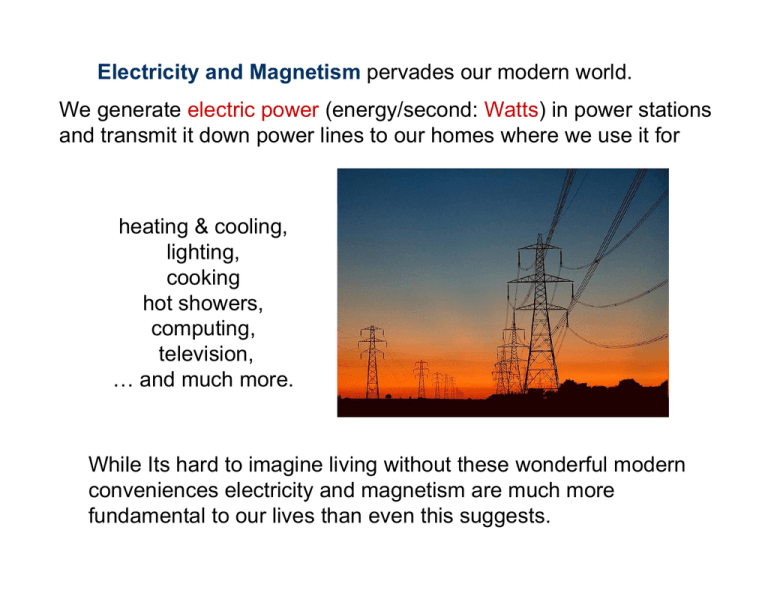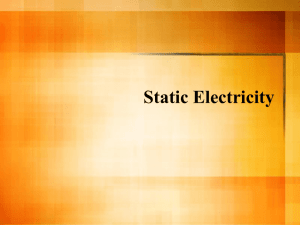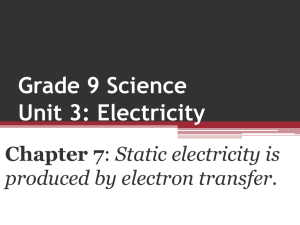Electricity and Magnetism pervades our modern world. We generate (energy/second:
advertisement

Electricity and Magnetism pervades our modern world. We generate electric power (energy/second: Watts) in power stations and transmit it down power lines to our homes where we use it for heating & cooling, lighting, cooking hot showers, computing, television, … and much more. While Its hard to imagine living without these wonderful modern conveniences electricity and magnetism are much more fundamental to our lives than even this suggests. Our understanding of the matter making up the world (including ourselves and all life) is that it is comprised of atoms of the elements: These atoms themselves are comprised of three, still smaller, constituents: Electrons, Protons and Neutrons The atom Planetary model (Neils Bohr): electrons orbit around nucleus held in place by the electrostatic force. electron (~ 1/1000 mass of nucleons) proton neutron nucleons (comprise nucleus) nucleon number 4He – 2 protons + 2 neutrons in nucleus (2 electrons “orbiting”) ( 3He also exists 2 p+, but 1 n (still 2 e-) called an isotope) (This picture has been greatly refined by quantum mechanics but that’s another course you may get later. This model remains conceptually useful for our purposes.) Electrons and protons have a property we call charge that is measured in units of Coulombs (C). The charge of the electron is 4He 1.602x10-19 C The charge of the proton is +1.602x10-19 C Electrons and protons have charge of exactly the same magnitude but different sign. This smallest magnitude of charge is often designated e = 1.602x10-19 C The significance of the sign is the following: Like charges (same sign) repel each other with the electrostatic force Opposite charges (opposite sign) attract with the electrostatic force Neutrons are neutral and are not affected by electrostatic forces. Electrons and protons can be liberated from the atom to exist as free charged particles. 4He A free electron and free proton (opposite sign charges) will attract each other with the electrostatic force to form an electrically neutral hydrogen atom. Stable atoms are electrically neutral because they have an equal number of electrons and protons. Aluminum (Al) has 13 protons in its nucleus. To be electrically neutral it must have 13 electrons. If an atom of Al were missing 2 electrons it would have a charge of +2e. Placed in the vicinity of free electrons it would attract them with the electrostatic force, capturing 2 of them, after which it would become electrically neutral and no longer attract further electrons. You may wonder: if like charges repel how come the protons can be so close together in the nucleus? This is because another force acts in the nucleus called the strong force (not a very imaginative name… but there it is). Both the electrostatic force and the strong force fall off (decrease) with increasing distance between the particles. The strong force is much stronger at very close particle distances but it falls off much more quickly with increasing distance. The strong force dominates inside the nucleus while the electrostatic force dominates outside the nucleus. You may also wonder why electrons don’t just spiral in to merge with the protons there? No one has a real answer to that question. In the early 1900’s Neils Bohr, inventor of this planetary model and one of the founders of quantum mechanics, stamped his foot and declared it so. Actually, using the assumption that electrons can only exist in particular, stable (quantized) orbits in an atom he was able to explain a number of otherwise very puzzling phenomena (garnering him the Nobel Prize for Physics in 1922). But we digress. The electrostatic force between elementary (point) charges is given by Coulomb’s law, Where: G q1q 2 F1,2 = k 2 rˆ r r q2 r̂ q1 q1 is the signed amount of charge on particle 1 (in Coulombs) q2 is the signed amount of charge on particle 2 (in Coulombs) The subscripts mean that this is the force experienced by particle 1 due to particle 2. r is the distance between the charges r̂ is a unit vector pointing from particle 2 to particle 1 2 1 N ⋅ m k is a constant, often written as k = = 8.99 × 109 4 πεo C2 2 C −12 where the permittivity constant, ε o = 8.85 × 10 N ⋅ m2 Example: Consider q1 = – e (an electron) fixed at the origin and q2= + e (a proton) fixed along the x axis at x = 1 m. What is the force on the electron (q1) from the proton? G q1q 2 F1,2 = k 2 rˆ r y -e î r̂ +e x x=1m In this case, r̂ = −ˆi and r = 1 m , so, 2 G ( −e)( +e) ˆ e2 ˆ (1.60 × 10−19 C) 2 ˆ 9 N⋅m F1,2 = k ( − i) = k 2 i = (8.99 × 10 ) i 2 2 2 r r C (1 m ) G F1,2 = 2.3 × 10−28 N ˆi Note that the direction of the vector force ends up being toward positive î , as it should, because the charges have opposite sign and thus the proton is attracting the electron. What is the force acting on the proton at x = 1 m due to the electron at the origin? G q1q 2 F2,1 = k 2 rˆ r (switched) y -e r̂ = ˆi +e x x=1m Now r̂ = ˆi , so, G ( −e)( + e) ˆ e2 ˆ −28 ˆ F2,1 = k i k i 2.30 10 Ni = − = − × r2 r2 The magnitude is the same but the vector force on the proton is in the opposite direction, now toward the origin, the location of the electron (this must be true by Newton’s third law ). We used an explicit labeling scheme and vector convention above to show how it goes, but it is often simpler to just calculate the magnitude of the electrostatic force and insert the appropriate vector direction based on whether the charges repel or attract. In that case we drop the subscripts on F (the vector electrostatic force on q1 due to q2 , will always be equal and opposite of that on q2 due to q1) and use the absolute values of q1 and q2 so that the magnitude of the force is, | q || q | F=k 1 2 2 r or q1q 2 F=k 2 r where the absolute values of q1 and q2 are understood The sign for the vector force is then put in depending on the signs and locations (in the coordinate system) of the charges q1 and q2. Electrostatic forces obey the principle of superposition so if there are more than two charges the net force on any one of them is given by the vector sum of the electrostatic forces from each of the others. Consider charges –e at the origin and +e at x = 1 m. We ask what is the net force experienced by a third charge +e at x = 2 m? y q1= –e q2= +e q3= +e 1m 2m x The force on q3 due to q2 (only) has magnitude, 1 | q 3 || q 2 | 1 e2 1 e2 e2 −2 = = = F3,2 = 1m ( ) 2 2 2 4πεo r 4πεo (2m − 1m) 4 πεo (1m) 4 πεo Since q2 and q3 have the same sign q3 is repelled, so the force on q3 from q2 (only) has this magnitude in direction + î . y q1= –e q2= +e q3= +e 1m 2m x The force on q3 due to q1 (only) meanwhile has magnitude, 1 | q 3 || q1 | 1 e2 1 e2 e2 = = = F3,1 = 2 2 2 4πεo r 4πεo (2m − 0m) 4 πεo (2m) 4πεo ⎡ 1 −2 ⎤ ⎢⎣ 4 m ⎥⎦ Since q3 and q1 have opposite sign the force between them is attractive so this force on q3 has direction − î . The net force on q3 is the vector sum of these, 2 G G G e2 e ⎡⎣1m −2 ⎤⎦ ˆi + F3 = F3,2 + F3,1 = 4πεo 4πεo ( ) ⎡ 1 −2 ⎤ ˆ ⎢⎣ 4 m ⎥⎦ − i y q1= –e So, G e2 F3 = 4 πεo q2= +e q3= +e 1m 2m x e 2 ⎛ 3 −2 ⎞ ˆ ⎡ ⎛ 1 ⎞ −2 ⎤ ˆ ⎢⎜ 1 − 4 ⎟ m ⎥ i = 4 πε ⎜ 4 m ⎟ i ⎠ ⎠ ⎣⎝ ⎦ o ⎝ Pointing away from q1 and q2 along + î . Does this make sense? The force from q2 (only) was in this direction but equal to, 2 G G e e2 ⎛ 3 −2 ⎞ ˆ −2 ˆ F3,2 = 1m ) i which is > the net force F3 = ( ⎜ m ⎟i 4 πεo ⎝ 4 4πεo ⎠ That the net force is smaller makes sense since the attractive force from q1 charge at the origin partly compensates the repulsive force from q2 causing the decrease. The compensation is far from complete since the electrostatic force falls off as 1/r2 and q1 was further away. Materials bodies (made up of atoms), can also be electrically charged. They can have an excess of electrons (beyond the number that neutralize all the positive atomic cores) charging the overall body negative, or they can have a deficit of electrons resulting in the body having an overall positive charge. Note that what matters is not the total number of electrons and protons but only the excess number of each. While charge is quantized in the smallest fundamental charge (e) this is so small (0.0000000000000000001602 C) that we often treat it as a continuous variable. Thus some configuration of charged bodies can be specified by giving the locations of signed quantities of charge e.g. +q1 , -q2 , … In many cases we can assume that the separation of the charges on the bodies is so small (compared to the distance between bodies) that the charges +q1 , -q2 , … themselves are point particles. Example z +q d d/2 r −d / 2 +qo y –q A charge +qo lies on the y axis a distance r from the origin. What is the electrostatic force on it from the charges +q and –q (equal but opposite sign) lying on the z axis at ±d/2 (+q and –q separated by d). We apply Coulomb’s force law between +qo and each of the other the other charges, in turn. z The relevant distance in the denominator of the force law is the distance between the particles so we label these distances r+ and r- , as shown. +q d r+ d/2 r −d / 2 –q r− +qo y z The magnitude of the force between +q an +qo is then, q oq F+ = k 2 r+ +q r+ d/2 +qo y G F+ r This force acts along the line between +q and +qo, and because they have the same sign, the force is repulsive, resulting in the force vector (of magnitude F+) shown. Similarly, the magnitude of the force between -q and qo is, q oq F− = k 2 r− But the opposite signs on the charges result in an attractive force giving the vector (of magnitude F-) shown. z r −d / 2 –q r− G F− +qo y G G G The net force F on +qo is the vector sum of F+ and F− . By symmetry we see G that +q the G components of F+ and r+ F− along the y axis are d/2 +qo y G equal and opposite, such d F+ r G G that when they are summed −d / 2 F− F G they cancel each other, while r− F− –q their components along the z axis are equal and in the same G direction. These mean that the resultant F lies in the − k̂ Gdirection G with magnitude given by twice the z component of either F+ or F− . G The z component of F+ is F+ z = F+ sin θ So the net force on +q is, G ˆ F = 2F+ sin θ ( − k) z +q r+ d/2 r θ +qo y G θ F+ z F+ From the sketch we see that d/2 sin θ = while, Then, G z +q r+ r+ d/2 q oq F+ = k 2 r+ r ˆ = 2k q o q d / 2 ( − k) ˆ F = 2F+ sin θ ( − k) 2 r+ r+ G q o qd ˆ F = k 3 ( − k) r+ +qo y G θ F+ z F+ ⎛d⎞ r+ = r 2 + (d / 2) 2 = r 1 + ⎜ ⎟ ⎝ 2r ⎠ q o qd ˆ ( − k) Also from the sketch, G so finally, F = k θ 2 ⎛ d ⎛ ⎞ ⎞ 3 r ⎜1 + ⎜ ⎟ ⎟ ⎝ ⎝ 2r ⎠ ⎠ 3 2 2







